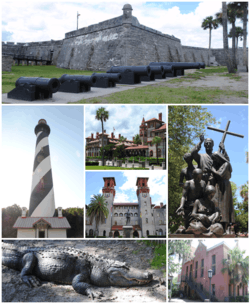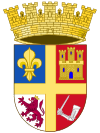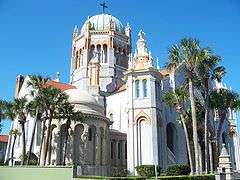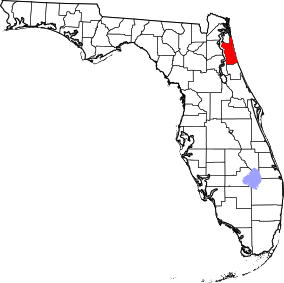St. Augustine, Florida
| St. Augustine San Agustín (Spanish) | ||
|---|---|---|
| City | ||
| City of St. Augustine | ||
|
Top, left to right: Castillo de San Marcos, St. Augustine Light, Flagler College, Lightner Museum, statue near the Cathedral Basilica of St. Augustine, St. Augustine Alligator Farm Zoological Park, Old St. Johns County Jail | ||
| ||
| Nickname(s): Ancient City, Old City | ||
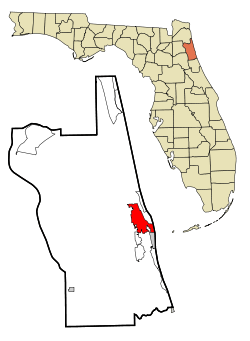 Location in St. Johns County and the U.S. state of Florida | ||
 St. Augustine St. Augustine | ||
| Coordinates: 29°53′41″N 81°18′52″W / 29.89472°N 81.31444°WCoordinates: 29°53′41″N 81°18′52″W / 29.89472°N 81.31444°W[1] | ||
| Country |
| |
| State |
| |
| County |
| |
| Established |
September 1565, 451 years ago | |
| Founded by | Pedro Menéndez de Avilés | |
| Named for | Saint Augustine of Hippo | |
| Government | ||
| • Type | Commission–Manager | |
| • Mayor | Nancy Shaver | |
| Area[1] | ||
| • City | 12.7 sq mi (33 km2) | |
| • Land | 9.4 sq mi (24 km2) | |
| • Water | 3.3 sq mi (9 km2) | |
| Elevation[2] | 0 ft (0 m) | |
| Population (2010)[3] | ||
| • City | 12,975 | |
| • Estimate (2013)[4] | 13,679 | |
| • Density | 1,376.2/sq mi (531.4/km2) | |
| • Urban | 69,173 (US: 399th) | |
| Time zone | EST (UTC-5) | |
| • Summer (DST) | EDT (UTC-4) | |
| ZIP code(s) | 32080, 32084, 32085, 32086, 32095, 32082, 32092 | |
| Area code(s) | 904 | |
| FIPS code | 12-62500[5] | |
| GNIS feature ID | 0308101[2] | |
| Website | City of St. Augustine | |
St. Augustine (Spanish: San Agustín) is a city in the southeastern United States, on the Atlantic coast in northeastern Florida. It is the oldest continuously occupied European-established settlement within the borders of the contiguous United States.[6]
The county seat of St. Johns County,[7] it is part of Florida's First Coast region and the Jacksonville metropolitan area. According to the 2010 census, the city population was 12,975. The United States Census Bureau's 2013 estimate of the city's population was 13,679, while the urban area had a population of 69,173 in 2012.[8]
Saint Augustine was founded 451 years ago on September 8, 1565, by Spanish admiral Pedro Menéndez de Avilés, Florida's first governor. He named the settlement "San Agustín," as his ships bearing settlers, troops, and supplies from Spain had first sighted land in Florida eleven days earlier on August 28, the feast day of St. Augustine.[9] The city served as the capital of Spanish Florida for over 200 years, and became the capital of British East Florida when the territory briefly changed hands between Spain and Britain.
Spain ceded Florida to the United States in 1819, and when the treaty was ratified in 1821, St. Augustine was designated the capital of the Florida Territory until Tallahassee was made the capital in 1824. Since the late 19th century, St. Augustine's distinct historical character has made the city a major tourist attraction, and it is also the headquarters for the Florida National Guard.
History
Founding by Pedro Menéndez de Avilés
Founded in 1565 by the Spanish conquistador, Pedro Menéndez de Avilés, St. Augustine is the oldest continuously occupied settlement of European origin in the United States. In 1562, a group of Huguenots led by Jean Ribault arrived in Spanish Florida to establish a colony in the territory claimed by Spain. They explored the mouth of the St. Johns River, calling it la Rivière de Mai (the River May), then sailed northward and established a settlement called Charlesfort at Port Royal Sound in present-day South Carolina. Spain learned of this French expedition through its spies at ports on the Atlantic coast of France. The Huguenot nobleman René de Laudonnière, who had participated in the expedition, returned to Florida in 1564 with three ships and 300 Huguenot colonists. He arrived at the mouth of the River May on June 22, 1564, sailed up it a few miles, and founded Fort Caroline.
Desiring to protect its claimed territories in North America against such incursions, the Spanish Crown issued an asiento to Menéndez, signed by King Philip II on March 20, 1565, granting him expansive trade privileges, the power to distribute lands, licenses to sell 500 slaves, as well as various titles, including that of adelantado of Florida.[10] This contract directed Menéndez to sail for La Florida, reconnoitre it from the Florida Keys to present-day Canada, and report on its coastal features, with a view to establishing a permanent colony for the defense of the Spanish treasure fleet. He was ordered as well to drive away any intruders who were not subjects of the Spanish crown.[11]
On July 28, Menéndez set sail from Cádiz with a fleet led by his 600-ton flagship, the San Pelayo, accompanied by several smaller ships, and carrying over 1,000 sailors, soldiers, and settlers.[12] On the feast day of St. Augustine, August 28, the fleet sighted land and anchored off the north inlet of the tidal channel the French called the River of Dolphins.[13] Menéndez then sailed north and confronted Ribault's fleet outside the bar of the River May in a brief skirmish. On September 6, he returned to the site of his first landfall, naming it after the Catholic saint, disembarked his troops, and quickly constructed fortifications to protect his people and supplies.[14][15]
Menéndez then marched his soldiers overland for a surprise attack on Fort Caroline, where they killed almost everyone in the fort except for the women and children. Jean Ribault had already put out to sea with his ships for an assault on St. Augustine, but was surprised by a storm that wrecked his ships further south. Informed by his Indian allies that the survivors were walking northward on the coast, Menéndez began to search for the Frenchmen, who had made it as far as the banks of the river's south entrance.[16] There they were confronted by the Spaniard and his men on the opposite side. After several parleys with the Spanish, Jean Ribault and the Frenchmen with him (between 150–350, sources differ) surrendered; almost all of them were executed in the dunes near the inlet, thereafter called Matanzas (Spanish for "slaughters").[17]
In May 1566, as relations with the neighboring Timucua Indians deteriorated, Menéndez moved the Spanish settlement to a more defensible position on the north end of the barrier island between the mainland and the sea, and built a wooden fort there. In 1572, the settlement was relocated to the mainland, in the area just south of the future town plaza. Confident that he had fulfilled the primary conditions of his contract with the King, including the building of forts along the coast of La Florida, Menéndez returned to Spain in 1567. After several more transatlantic crossings, Menéndez fell ill and died on September 17, 1574.[18]
Invasions by pirates and enemies of Spain
Succeeding governors of the province maintained a peaceful coexistence with the local Native Americans, allowing the isolated outpost of St. Augustine some stability for a few years. On May 28 and 29, 1586, soon after the Anglo-Spanish War began between England and Spain, the English privateer Sir Francis Drake sacked and burned St. Augustine.[19] The approach of his large fleet obliged Governor Pedro Menéndez Márquez and the townspeople to flee for their safety. When the English got ashore, they seized some artillery pieces and a royal strongbox containing gold ducats, the garrison payroll.[20] The killing of their sergeant major by the Spanish rearguard caused Drake to order the town burnt.[21][22]
In 1609 and 1611, expeditions were sent out from St. Augustine against the English settlement at Jamestown, Virginia.[23] In the second half of the 17th century, unsettled groups of Indians, forced southward by the expanding English colony in Carolina, made raids into Florida and killed the Franciscan priests who served at the Catholic missions. Requests by successive governors of the province to strengthen the presidio’s garrison and fortifications were ignored by the Crown. The charter of 1663 for the new Province of Carolina, issued by King Charles II of England, was revised in 1665, claiming lands as far southward as 29 degrees north latitude, about 65 miles south of the existing Spanish settlement at St. Augustine.[24][25]
The English buccaneer Robert Searle then sacked St. Augustine in 1668, killing sixty people and pillaging government buildings, churches and houses,[26] after which his pirates ransomed off some of their hostages and sold others into slavery. This raid and the establishment of the English settlement at Charles Town spurred the Spanish monarchy to finally acknowledge the threat represented by the new English colonies to the north and strengthen the city's defenses. In 1669, Queen Regent Mariana ordered the Viceroy of New Spain to disburse funds for the construction of a permanent masonry fortress, which began in 1672.[27] The Castillo de San Marcos was completed in 1695, not long before an attack by Governor Moore's forces from Carolina in November, 1702. Failing to take the fort after a siege of 58 days, the British troops burned St. Augustine to the ground as they retreated.[28] In 1740, the town was again besieged, this time by the governor of the British colony of Georgia, General James Oglethorpe, who was also unable to take the fort.[29]
Loyalist haven under British rule
The Treaty of Paris (1763), signed after Great Britain's victory over France and Spain during the Seven Years' War, ceded Florida to Great Britain and consequently St. Augustine became a Loyalist haven during the American Revolutionary War.[30] The second Treaty of Paris (1783), which recognized the independence of the former British colonies north of Florida, also ceded Florida back to Spain, and as a result many of the town's Spanish citizens returned to St Augustine. Refugees from Dr. Andrew Turnbull's troubled colony in New Smyrna had fled to St. Augustine in 1777, and made up the majority of the city's population during British rule. This group was (and still is) referred to locally as "Minorcans", even though it also included settlers from Corsica, Italy and the Greek islands as well.[31][32]
Second Spanish Period
During the Second Spanish Period (1784-1821) of its rule in Florida, Spain was dealing with invasions of the Iberian peninsula by Napoleon's armies in the Peninsular War, and struggled to maintain a tenuous hold on its colonies in the western hemisphere as revolution swept South America. The royal administration of Florida was neglected, as the province had long been regarded as an unprofitable backwater by the Crown. The United States, however, considered Florida vital to its political and military interests as it expanded its territory in North America, and maneuvered by sometimes clandestine means to acquire it.[33] The Adams–Onís Treaty, negotiated in 1819 and concluded in 1821, ceded Florida and St. Augustine, still its capital at the time, to the United States.[34]
Territory of Florida
Florida remained an organized territory of the United States until 1845, when it was admitted into the Union as the State of Florida.[35] The Territorial Period (1821-1845) was marked by protracted wars with the Creek Indian groups who occupied the peninsula, collectively known as "Seminoles", during the Second Seminole War (1835-1842). The United States Army took command of the Castillo de San Marcos and renamed it Fort Marion after General Francis Marion, who fought in the American Revolutionary War.
Civil War
Florida joined the Confederacy after the Civil War began in 1861, and Confederate authorities remained in control of St. Augustine for fourteen months, even though it was barely defended, and in spite of the Union blockade of shipping off the coast. Union troops occupied St. Augustine in 1862 and controlled the city through the rest of the war. Its economy already devastated, many of the town's citizens fled.[36][37]
Henry Flagler and the railroad
Henry Flagler, a co-founder with John D. Rockefeller of the Standard Oil Company, spent the winter of 1883 in St. Augustine and found the city charming, but considered its hotels and transportation systems inadequate.[38] He had the idea to make St. Augustine a winter resort for wealthy Americans from the north, and to bring them south he bought several short line railroads and combined these in 1885 to form the Florida East Coast Railway. He built a railroad bridge over the St. Johns River in 1888, opening up the Atlantic coast of Florida to development.[39][40]
Flagler began construction in 1887 of two large ornate hotels, the 540-room Ponce de León Hotel and the Hotel Alcazar, and bought the Casa Monica Hotel the next year. His chosen architectural firm, Carrère and Hastings, radically altered the appearance of St. Augustine and gave it a skyline, beginning an architectural trend in the state characterized by the use of elements of the Moorish Revival style. With the opening of the Ponce in 1888, St. Augustine became the winter resort of American high society for a few years.[41]
After Flagler's Florida East Coast Railroad had been extended southward to Palm Beach and then Miami, the rich mostly abandoned St. Augustine in the early 20th century and began to customarily spend their winters in South Florida, where the climate was warmer and freezes were rare. St. Augustine nevertheless still attracted tourists, and eventually became a destination for families traveling in automobiles as new roads were built and Americans took to the road for annual summer vacations. The tourist industry soon became the dominant sector of the local economy.[42] With the help of state and federal government monies, St. Augustine began a program in 1935 to preserve thirty-six surviving colonial buildings and reconstruct others that were gone.
Modern St. Augustine
In 1965, St. Augustine celebrated the quadricentennial of its founding,[43] and jointly with the State of Florida, inaugurated a program to restore part of the colonial city. When the State of Florida abolished the Historic St. Augustine Preservation Board in 1997, the City of St. Augustine assumed control of more than thirty-six buildings that had been reconstructed or restored to their historical appearance, as well as other historic properties including the Government House. In 2015, St. Augustine celebrated its 450th year of its founding with a visit from Felipe VI of Spain and Queen Letizia of Spain.[44] On October 7, 2016 Hurricane Matthew caused widespread flooding in downtown St. Augustine.[45]
Geography and climate
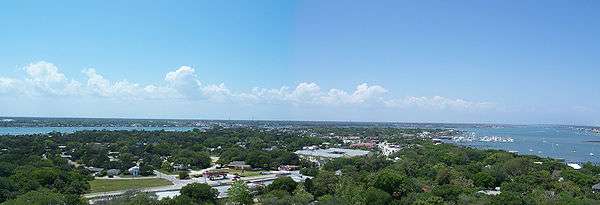
St. Augustine is located at 29°53′41″N 81°18′52″W / 29.89472°N 81.31444°W (29.8946910, −81.3145170).[1] According to the United States Census Bureau, the city has a total area of 10.7 square miles (27.8 km2), 8.4 square miles (21.7 km2) of which is land and 2.4 square miles (6.1 km2) (21.99%) is water. Access to the Atlantic Ocean is via the St. Augustine Inlet of the Matanzas River.
St. Augustine has a humid subtropical climate or Cfa – typical of the Gulf and South Atlantic states. The low latitude and coastal location gives the city a mostly warm and sunny climate. Like much of Florida, St. Augustine enjoys a high number of sunny days, averaging 2,900 hours annually. Unlike much of the continental United States, St. Augustine’s driest time of year is winter. The hot and wet season extends from May through October, while the cool and dry season extends November through April.
In the hot season average daytime highs are in the upper 80s to low 90s °F (26° to 33 °C) and average night-time lows are in the low 70s °F (21 °C). The Bermuda High pumps in hot and unstable tropical air from the Bahamas and Gulf of Mexico, which help create the daily thundershowers that are typical in summer months. Intense but very brief downpours are common in mid-summer in the city. Fall and spring are warm and sunny with highs in the 75 to 80 F (21 to 24 °C) range and overnight lows in the 50s to low 60s (10 to 17 °C).
In the dry winter season, St. Augustine has mild and sunny weather typical of the Florida peninsula. The coolest months are from December through February, with average daytime highs that range from 65 to 70 °F (18 to 21 °C) and nighttime lows in the 46-49 F (8 to 10 °C) range. From November through April, St. Augustine often has long periods of rainless weather. Early spring (April) can see near drought conditions with brush fires and water restrictions in place. St. Augustine averages six frosts per year. Hurricanes occasionally impact the region; however, like most areas prone to such storms, St. Augustine rarely suffers a direct hit by a major hurricane. The last direct hit by a major hurricane to the city was Hurricane Dora in 1964. Extensive flooding occurred in the downtown area of St. Augustine when Hurricane Matthew passed east of the city in October 2016.[46]
| Climate data for St. Augustine | |||||||||||||
|---|---|---|---|---|---|---|---|---|---|---|---|---|---|
| Month | Jan | Feb | Mar | Apr | May | Jun | Jul | Aug | Sep | Oct | Nov | Dec | Year |
| Record high °F (°C) | 87 (31) |
90 (32) |
94 (34) |
96 (36) |
99 (37) |
104 (40) |
103 (39) |
102 (39) |
100 (38) |
98 (37) |
92 (33) |
89 (32) |
104 (40) |
| Average high °F (°C) | 66 (19) |
69 (21) |
73 (23) |
78 (26) |
84 (29) |
88 (31) |
90 (32) |
89 (32) |
86 (30) |
81 (27) |
74 (23) |
68 (20) |
79 (26) |
| Average low °F (°C) | 46 (8) |
49 (9) |
53 (12) |
58 (14) |
65 (18) |
71 (22) |
72 (22) |
73 (23) |
71 (22) |
65 (18) |
56 (13) |
49 (9) |
61 (16) |
| Record low °F (°C) | 10 (−12) |
18 (−8) |
23 (−5) |
33 (1) |
41 (5) |
52 (11) |
58 (14) |
59 (15) |
51 (11) |
31 (−1) |
25 (−4) |
16 (−9) |
10 (−12) |
| Average precipitation inches (mm) | 2.7 (69) |
3.1 (79) |
3.9 (99) |
2.6 (66) |
3.1 (79) |
5.6 (142) |
5.7 (145) |
6.5 (165) |
7.5 (191) |
4.6 (117) |
2.3 (58) |
2.4 (61) |
49.49 (1,257) |
| Source: [47] | |||||||||||||
Demographics
| Historical population | |||
|---|---|---|---|
| Census | Pop. | %± | |
| 1830 | 1,708 | — | |
| 1840 | 2,450 | 43.4% | |
| 1850 | 1,934 | −21.1% | |
| 1860 | 1,914 | −1.0% | |
| 1870 | 1,717 | −10.3% | |
| 1880 | 2,293 | 33.5% | |
| 1890 | 4,742 | 106.8% | |
| 1900 | 4,272 | −9.9% | |
| 1910 | 5,494 | 28.6% | |
| 1920 | 6,192 | 12.7% | |
| 1930 | 12,111 | 95.6% | |
| 1940 | 12,090 | −0.2% | |
| 1950 | 13,555 | 12.1% | |
| 1960 | 14,734 | 8.7% | |
| 1970 | 12,352 | −16.2% | |
| 1980 | 11,985 | −3.0% | |
| 1990 | 11,692 | −2.4% | |
| 2000 | 11,592 | −0.9% | |
| 2010 | 12,975 | 11.9% | |
| Est. 2015 | 14,128 | [48] | 8.9% |
As of the 2010 United States Census, there were 12,975 people, 5,743 households, and 2,679 families residing in the city. The population density was 1,376.2 people per square mile (531/km²). There were 6,978 housing units at an average density of 549.4 per square mile (211.4/km²). The racial makeup of the city was 84.2% Caucasian, 11.6% African American, 0.4% Native American, 1.2% Asian, 0.1% Pacific Islander, 0.8% from other races, and 1.6% from two or more races. Hispanic or Latino of any race were 5.1% of the population.
There were 5,743 households out of which 14.6% had children under the age of 18 living with them, 31.7% were married couples living together, 10.9% had a female householder with no husband present, and 53.4% were non-families. 37.8% of all households were made up of individuals and 14.4% had someone living alone who was 65 years of age or older. The average household size was 2.03 and the average family size was 2.67.
In the city the population was spread out with 13.1% under the age of 18, 15.3% from 18 to 24, 23.9% from 25 to 44, 25.2% from 45 to 64, and 19% who were 65 years of age or older. The median age was 42.6 years. For every 100 females there were 88.1 males. For every 100 females age 18 and over, there were 85.8 males.
The median income for a household in the city was $36,424, and the median income for a family was $56,055. Males had a median income of $32,409 versus $30,188 for females. The per capita income for the city was $23,485. About 7.6% of families and 21.1% of the population were below the poverty line, including 18.8% of those under age 18 and 24.4% of those age 65 or over.
Transportation
Highways
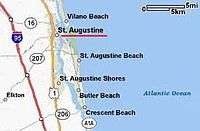
-
 Interstate 95 runs north–south.
Interstate 95 runs north–south. -
 U.S. Route 1 runs north–south.
U.S. Route 1 runs north–south. -
 State Road A1A runs north–south.
State Road A1A runs north–south. -
 State Road 16 runs east–west
State Road 16 runs east–west -
 State Road 207 runs northeast–southwest
State Road 207 runs northeast–southwest -
 State Road 312 runs east–west
State Road 312 runs east–west
Buses
Bus service is operated by the Sunshine Bus Company. Buses operate mainly between shopping centers across town, but a few go to Hastings and Jacksonville, where one can connect to JTA for additional service across Jacksonville.
Airport
St. Augustine has one public airport 4 miles (6.4 km) north of town. It has six runways (with three water runways for seaplanes).[50] The airport was once served by Skybus, however Skybus ceased operations as of April 4, 2008.[51] In addition to private flights and tour helicopters, Frontier Airlines provides service to Philadelphia International Airport and Chicago O’Hare International Airport.[52]
Points of interest
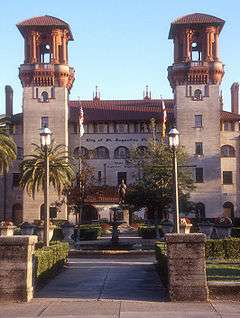
Spanish Eras
- Avero House
- Castillo de San Marcos National Monument
- Fort Matanzas National Monument
- Fort Mose Historic State Park
- Nombre de Dios
- Gonzalez-Alvarez House
- Fountain of Youth Archaeological Park
- The Spanish Military Hospital Museum
- St. Francis Barracks
- Colonial Quarter
- Ximenez-Fatio House
- Oldest Wooden Schoolhouse
- Tolomato Cemetery and Huguenot Cemetery
British Era
Pre-Flagler Era
- St. Augustine Lighthouse and Museum
- Markland Mansion
Flagler Era
- Ponce de León Hotel
- Casa Monica Hotel
- Hotel Alcazar
- Zorayda Castle
- Bridge of Lions
- Old St. Johns County Jail
- Ripley's Believe it or Not! Museum located in 1887 mansion of William Worden.
- Alligator Farm
Historic Churches
- Grace United Methodist Church
- Cathedral Basilica of St. Augustine
- Memorial Presbyterian Church
- Trinity Church of St. Augustine
- First Congregation Sons of Israel
Lincolnville National Historic District – Civil Rights Era
- Freedom Trail of Historic Sites of the Civil Rights Movement
- Excelsior School Museum of African American History
- St. Benedict the Moor School
Other
- Anastasia State Park
- Florida School for the Deaf and Blind
- St. Augustine Amphitheatre
- St. Augustine Pirate & Treasure Museum
- World Golf Hall of Fame
Sister cities
-

 Avilés, Asturias, Spain
Avilés, Asturias, Spain -
 Cartagena, Colombia
Cartagena, Colombia -

 Minorca, Balearic Islands, Spain
Minorca, Balearic Islands, Spain -
 Santo Domingo, Dominican Republic
Santo Domingo, Dominican Republic
Education

Primary and secondary education in St. Augustine is overseen by the St. Johns County School District. There are no county high schools located within St. Augustine's current city limits, but St. Augustine High School, Pedro Menendez High School, and St. Johns Technical High School are located in the vicinity. The Florida School for the Deaf and Blind, a state-operated boarding school for deaf and blind students, was founded in the city in 1885.[53] The Catholic Diocese of St. Augustine operates the St. Joseph Academy, Florida's oldest Catholic high school, to the west of the city.[54]
There are several institutions of higher education in and around St. Augustine. Flagler College is a four-year liberal arts college founded in 1968. It is located in the former Ponce de León Hotel in downtown St. Augustine.[55] St. Johns River State College, a state college in the Florida College System, has its St. Augustine campus just west of the city. Also in the area are the University of North Florida, Jacksonville University, and Florida State College at Jacksonville in Jacksonville.[56]
The institution now known as Florida Memorial University was located in St. Augustine from 1918 to 1968, when it relocated to its present campus in Miami. Originally known as Florida Baptist Academy, then Florida Normal, and then Florida Memorial College, it was a historically black institution and had a wide impact on St. Augustine while it was located there. During World War II it was chosen as the site for training the first blacks in the U. S. Signal Corps. Among its faculty members was Zora Neale Hurston; a historic marker is placed at the house where she lived while teaching at Florida Memorial[57] (and where she wrote her autobiography Dust Tracks on a Road.)[58][59]
Notable people
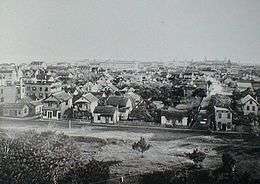
- Jim Albrecht, poker tournament director and commentator
- Andrew Anderson, physician, St. Augustine mayor
- John Alexander Armstrong, political theorist and scholar
- Murray Armstrong, hockey coach
- Frances Bemis, public relations specialist
- Jorge Biassou, Haitian revolutionary and first black American general
- Richard Boone, actor
- James Branch Cabell, novelist
- Doug Carn, jazz musician
- Cris Carpenter, Major League baseball player
- Ray Charles, pianist, singer, composer
- George J. F. Clarke, Surveyor General of Spanish East Florida
- Earl Cunningham, artist
- Alexander Darnes, born a slave, became a celebrated physician
- Edmund Jackson Davis, governor of Texas
- Frederick Delius, composer
- Henry Flagler, industrialist
- Willie Galimore, football player
- Michael Gannon, historian
- Laura Jane Grace, singer
- William H. Gray, U. S. congressman and president of the United Negro College Fund
- Robert Hayling, civil rights leader
- Hurley Haywood endurance race car driver[60]
- Martin Johnson Heade, artist
- Louise Homer, opera singer
- Sidney Homer, composer
- Jack D. Hunter, novelist, author of The Blue Max
- Zora Neale Hurston, novelist and folklorist
- Lindy Infante, professional football coach
- Willie Irvin, professional football player
- Brandon James, professional football player
- Stetson Kennedy, author and human rights activist
- Jack Temple Kirby, historian
- LaChanze, Tony Award & Emmy Award winning actor, singer, and dancer
- Scott Lagasse Jr., race car driver
- Charlie LaPradd, college football player, college president
- Jacob Lawrence, artist
- Sinclair Lewis, novelist
- John C. Lilly, neuroscientist, developer of the isolation tank
- William W. Loring, Confederate general
- Mary MacLane, author
- Albert Manucy, historian, author, Fulbright Scholar
- George McGovern, U.S. Senator, presidential candidate
- Howell W. Melton, United States district judge
- Howell W. Melton Jr., attorney, law firm managing partner
- Johnny Mize, Hall of Fame baseball player
- Prince Achille Murat, nephew of Napoleon Bonaparte
- David Nolan, author and historian
- Osceola, Seminole War leader (held prisoner at Fort Marion, now Castillo de San Marcos)
- Tom Petty, rock musician
- Scott Player, professional football punter
- Verle A. Pope, state legislator
- Richard Henry Pratt, soldier and educator
- Marjorie Kinnan Rawlings, novelist
- Marcus Roberts, musician
- Gamble Rogers, folksinger
- John M. Schofield, Union general
- Steven L. Sears, television writer-producer
- Sheamus, Irish professional wrestler
- Edmund Kirby Smith, Confederate general
- Steve Spurrier, college/pro (American) football coach
- Peter Taylor, novelist
- Travis Tomko, professional wrestler
- The Wobbly Toms, music group
- Felix Varela, Cuban national hero
- Augustin Verot, first Bishop of St. Augustine
- Patty Wagstaff, aerobatic pilot
- DeWitt Webb, physician, St. Augustine mayor, state representative
- David Levy Yulee, first Jewish U.S. Senator, Levy County and Yulee, Florida namesake
Gallery
-
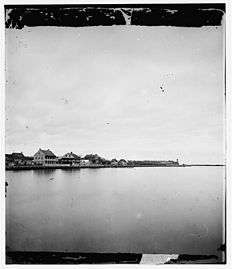
St. Augustine waterfront with Castillo de San Marcos in distance (1860s).
-

Government House as seen from the Town Plaza c. 1861–65
-
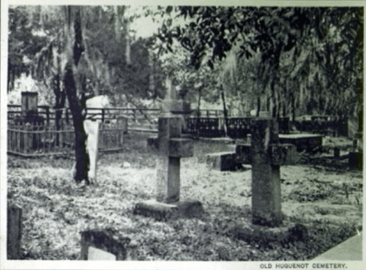
Historic Huguenot Cemetery
-
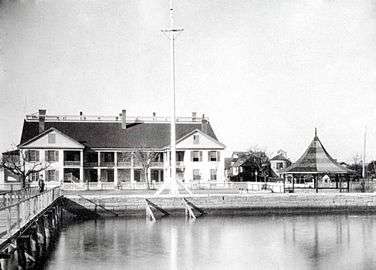
St. Francis Barracks, c.1890
-
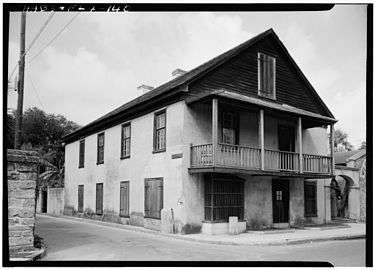
Tovar House, 22 St. Francis St.
-
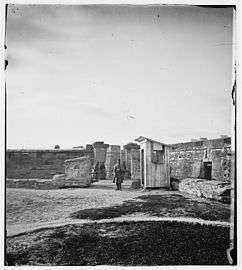
Castillo de San Marcos, Civil War era.
-

Panorama of Castillo de San Marcos, Flagler College and downtown St. Augustine from lighthouse, June 2011
-
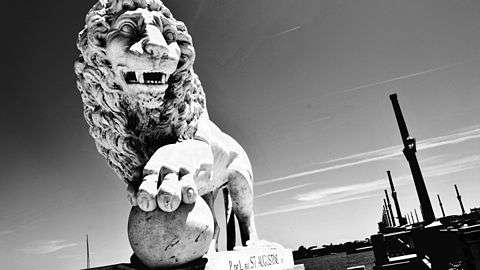
Replicas of the Medici lions at the Bridge of Lions, post restoration in 2011
See also
- Gálveztown (brig sloop) – ship which played a role in the Gulf Coast campaign of the American Revolutionary War under Bernardo de Gálvez, and its replica built recently in Spain anticipating the 450th anniversary of St. Augustine's founding (1565–2015).
References
- 1 2 3 "GNIS Detail – Saint Augustine". Geographic Names Information System. 2011-02-12. Retrieved 2011-04-23.
- 1 2 "US Board on Geographic Names". United States Geological Survey. 2007-10-25. Retrieved 2008-01-31.
- ↑ "State & County QuickFacts". Census.gov. U.S. Census Bureau, Population Division. April 1, 2010.
- ↑ "Population Estimates". United States Census Bureau. Retrieved 2015-04-22.
- ↑ "American FactFinder". United States Census Bureau. Retrieved 2008-01-31.
- ↑ "Florida: St. Augustine Town Plan Historic District". National Park Service.
- ↑ "Find a County". National Association of Counties. Retrieved 2011-06-07.
- ↑ "2012 Urbanized Area Population Estimates" (PDF). DOT.State.Fl.US. Florida Department of Transportation. April 1, 2012.
- ↑ Hennesey, James J. (10 December 1981). American Catholics: A History of the Roman Catholic Community in the United States: A History of the Roman Catholic Community in the United States. New York: Oxford University Press. p. 11. ISBN 978-0-19-802036-3.
- ↑ John T. McGrath (2000). The French in Early Florida: In the Eye of the Hurricane. University Press of Florida. p. 207. ISBN 978-0-8130-1784-6.
- ↑ Eugene Lyon (May 1983). The Enterprise of Florida: Pedro Menéndez de Avilés and the Spanish Conquest of 1565-1568. University Press of Florida. pp. 52–53. ISBN 978-0-8130-0777-9.
- ↑ Eugene Lyon (May 1983). The Enterprise of Florida: Pedro Menéndez de Avilés and the Spanish Conquest of 1565-1568. University Press of Florida. p. 98. ISBN 978-0-8130-0777-9.
- ↑ Pickett, Margaret F.; Pickett, Dwayne W. (8 February 2011). The European Struggle to Settle North America: Colonizing Attempts by England, France and Spain, 1521–1608. McFarland. p. 69. ISBN 978-0-7864-6221-6.
...Laudonnière decided to call it the River of Dolphins (today known as the Matanzas River, near St. Augustine).
- ↑ John W. Griffin; Patricia C. Griffin (1996). Fifty Years of Southeastern Archaeology: Selected Works of John W. Griffin. University Press of Florida. p. 184. ISBN 978-0-8130-1420-3.
- ↑ John William Reps (1965). The Making of Urban America: A History of City Planning in the United States. Princeton University Press. p. 33. ISBN 0-691-00618-0.
- ↑ Charlton W. Tebeau (1 January 1971). A History of Florida. University of Miami Press. p. 35. ISBN 978-0-87024-149-9.
- ↑ David J. Weber (1992). The Spanish Frontier in North America. Yale University Press. p. 62. ISBN 978-0-300-05917-5.
- ↑ Albert C. Manucy (1983). Menéndez: Pedro Menéndez de Avilés, Captain General of the Ocean Sea. Pineapple Press. p. 95.
- ↑ Spencer Tucker (21 November 2012). Almanac of American Military History. ABC-CLIO. p. 54. ISBN 978-1-59884-530-3.
- ↑ John Sugden (24 April 2012). Sir Francis Drake. Random House. p. 198. ISBN 978-1-4481-2950-8.
- ↑ Angus Konstam (20 December 2011). The Great Expedition: Sir Francis Drake on the Spanish Main 1585–86. Bloomsbury Publishing. p. 109. ISBN 978-1-78096-233-7.
- ↑ James W. Raab (5 November 2007). Spain, Britain and the American Revolution in Florida, 1763-1783. McFarland. p. 9. ISBN 978-0-7864-3213-4.
- ↑ Alan Gallay (11 June 2015). Colonial Wars of North America, 1512-1763 (Routledge Revivals): An Encyclopedia. Taylor & Francis. p. 326. ISBN 978-1-317-48718-0.
- ↑ "Charter of Carolina - March 24, 1663". Avalon Law. Lillian Goldman Law Library, Yale Law School. 2008. Archived from the original on February 7, 2009. Retrieved 10 February 2016.
- ↑ Walter B. Edgar (1998). South Carolina: A History. Univ of South Carolina Press. p. 1. ISBN 978-1-57003-255-4.
- ↑ Jon Latimer (1 June 2009). Buccaneers of the Caribbean: How Piracy Forged an Empire. Harvard University Press. p. 198. ISBN 978-0-674-03403-7.
- ↑ James W. Raab (5 November 2007). Spain, Britain and the American Revolution in Florida, 1763-1783. McFarland. pp. 10–11. ISBN 978-0-7864-3213-4.
- ↑ Walter B. Edgar (1998). South Carolina: A History. Univ of South Carolina Press. p. 93. ISBN 978-1-57003-255-4.
- ↑ Rodney E. Baine (2000). "General James Oglethorpe and the Expedition Against St. Augustine". The Georgia Historical Quarterly. Georgia Historical Society. 84 (2 Summer): 198. JSTOR 40584271.
- ↑ Patricia C. Griffin (1991). Mullet on the Beach: The Minorcans of Florida, 1768-1788. St. Augustine Historical Society. p. 108. ISBN 978-0-8130-1074-8.
- ↑ Jane G. Landers (2000). Colonial Plantations and Economy in Florida. University Press of Florida. pp. 41–42. ISBN 978-0-8130-1772-3.
- ↑ Patricia C. Griffin (1991). Mullet on the Beach: The Minorcans of Florida, 1768-1788. St. Augustine Historical Society. pp. 20–21. ISBN 978-0-8130-1074-8.
- ↑ Writers' Program (Fla.) (1940). Seeing Fernandina: A Guide to the City and Its Industries. Fernandina News Publishing Company. p. 23. Retrieved 3 May 2013.
- ↑ James A. Crutchfield; Candy Moutlon; Terry Del Bene (26 March 2015). The Settlement of America: An Encyclopedia of Westward Expansion from Jamestown to the Closing of the Frontier. Routledge. p. 51. ISBN 978-1-317-45461-8.
- ↑ Stephen W. Stathis (2 January 2014). Landmark Legislation 1774-2012: Major U.S. Acts and Treaties. SAGE Publications. p. 78. ISBN 978-1-4522-9229-8.
- ↑ Barbara E. Mattick (2003). "The Catholic Nuns of St. Augustine (1859–1869)". In Bruce Clayton, John A. Salmond. Lives Full of Struggle and Triumph: Southern Women, Their Institutions, and Their Communities. University Press of Florida. p. 117. ISBN 978-0-8130-3117-0.
- ↑ Paul Taylor (2001). Discovering the Civil War in Florida: A Reader and Guide. Pineapple Press Inc. p. 127. ISBN 978-1-56164-235-9.
- ↑ Sidney Walter Martin (1 February 2010). Florida's Flagler. University of Georgia Press. p. 130. ISBN 978-0-8203-3488-2.
- ↑ Jim Cox (24 February 2016). Rails Across Dixie: A History of Passenger Trains in the American South. McFarland. p. 85. ISBN 978-0-7864-6175-2.
- ↑ Walter W. Manley; E. Canter Brown; Eric W. Rise; Florida Supreme Court Historical Society (1997). The Supreme Court of Florida and Its Predecessor Courts, 1821-1917. University Press of Florida. p. 263. ISBN 978-0-8130-1540-8.
- ↑ Sidney Walter Martin (1 February 2010). Florida's Flagler. University of Georgia Press. pp. 117–118. ISBN 978-0-8203-3488-2.
- ↑ Tourism USA: Guidelines for Tourism Development : Appraising Tourism Potential, Planning for Tourism, Assessing Product and Market, Marketing Tourism, Visitor Services, Sources of Assistance. The University of Missouri. 1991. p. 87.
- ↑ History News. 20-21. American Association for State and Local History. 1965. p. 208.
- ↑ Gardner, Sheldon (July 16, 2015). "King and queen of Spain to visit St. Augustine in September". The St. Augustine Record. Retrieved 8 October 2016.
- ↑ Martin, Jake (October 8, 2016). "Hurricane Matthew: Surveying damage in St. Augustine the morning after". The St. Augustine Record. Retrieved 8 October 2016.
- ↑ Braun, Michael (8 October 2016). "Hurricane Matthew floods St. Augustine beach areas". (Fort Myers) News-Press. Retrieved 8 October 2016.
- ↑ "National Weather Service Climate". Nws.noaa.gov. 2006-07-21. Retrieved 2012-12-18.
- ↑ "Annual Estimates of the Resident Population for Incorporated Places: April 1, 2010 to July 1, 2015". Retrieved July 2, 2016.
- ↑ "Census of Population and Housing". Census.gov. Retrieved June 4, 2015.
- ↑ "SGJ – Northeast Florida Regional Airport – SkyVector". skyvector.com.
- ↑ Jordan, Douglas (April 6, 2008). "Skybus news 'disappointing'". St. Augustine Record. Retrieved June 16, 2014.. St. Augustine is also served by nearby Jacksonville International Airport 40 miles to the north which offers connections to many cities in the United States, Canada, and Europe.
- ↑ Troy Blevins (April 15, 2016). "Frontier Airlines begins new non-stop service in St. Augustine: Carrier to begin non-stop flights to Chicago-O'Hare, Philadelphia". News4jax.com. Graham Media Group. Archived from the original on April 21, 2016. Retrieved 7 July 2016.
- ↑ "Florida School for the Deaf and the Blind".
- ↑ "School is Tradition". The Florida Times-Union/Shorelines. February 13, 2003. Retrieved May 18, 2011.
- ↑ Reiss, Sarah W. (2009). Insiders' Guide to Jacksonville, 3rd Edition. Globe Pequot. p. 184. ISBN 0-7627-5032-4. Retrieved May 10, 2011.
- ↑ Reiss, Sarah W. (2009). Insiders' Guide to Jacksonville, 3rd Edition. Globe Pequot. pp. 184–187. ISBN 0-7627-5032-4. Retrieved May 18, 2011.
- ↑ Margaretta Jolly (4 December 2013). Encyclopedia of Life Writing: Autobiographical and Biographical Forms. Routledge. p. 450. ISBN 978-1-136-78744-7.
- ↑ Robert Wayne Croft (1 January 2002). A Zora Neale Hurston Companion. Greenwood Publishing Group. pp. 37–38. ISBN 978-0-313-30707-2.
- ↑ Harold Bloom (1 January 2009). Zora Neale Hurston. Infobase Publishing. pp. 38–39. ISBN 978-1-4381-1553-5.
- ↑ Seraphin, Charlie (5 December 2014). "People: Hurley Haywood". Old City Life.
Further reading
| Library resources about St. Augustine, Florida |
- Abbad y Lasierra, Iñigo, "Relación del descubrimiento, conquista y población de las provincias y costas de la Florida" – "Relación de La Florida" (1785); edición de Juan José Nieto Callén y José María Sánchez Molledo.
- Colburn, David, Racial Change and Community Crisis: St. Augustine, Florida, 1877–1980 (1985), New York: Columbia University Press.
- Corbett, Theodore G. "Migration to a Spanish imperial frontier in the seventeenth and eighteenth centuries: St. Augustine." Hispanic American Historical Review (1974): 414-430 in JSTOR
- Deagan, Kathleen, Fort Mose: Colonial America's Black Fortress of Freedom (1995), Gainesville: University Press of Florida.
- Fairbanks, George R. (George Rainsford), History and antiquities of St. Augustine, Florida (1881), Jacksonville, Florida, H. Drew.
- Gannon, Michael V., The Cross in the Sand: The Early Catholic Church in Florida 1513–1870 (1965), Gainesville: University Presses of Florida.
- Goldstein, Holly Markovitz, "St. Augustine's "Slave Market": A Visual History," Southern Spaces, 28 September 2012.
- Gordon, Elsbeth, Florida's Colonial Architectural Heritage, University Press of Florida, 2002; Heart and Soul of Florida: Sacred Sites and Historic Architecture, University Press of Florida, 2013
- Graham, Thomas, The Awakening of St. Augustine, (1978), St. Augustine Historical Society
- Hanna, A. J., A Prince in Their Midst, (1946), Norman: University of Oklahoma Press.
- Harvey, Karen, America's First City, (1992), Lake Buena Vista, Florida: Tailored Tours Publications.
- Harvey, Karen, St. Augustine Enters the Twenty-first Century, (2010), Virginia Beach, VA: The Donning Company.
- Landers, Jane, Black Society in Spanish Florida (1999), Urbana and Chicago: University of Illinois Press.
- Lardner, Ring, Gullible's Travels, (1925), New York: Scribner's.
- Lyon, Eugene, The Enterprise of Florida, (1976), Gainesville: University Press of Florida.
- Manucy, Albert, Menendez, (1983), St. Augustine Historical Society.
- Marley, David F. (2005), "United States: St. Augustine", Historic Cities of the Americas, 2, Santa Barbara, California: ABC-CLIO, p. 627+, ISBN 1-57607-027-1
- McCarthy, Kevin (editor), The Book Lover's Guide to Florida, (1992), Sarasota, Florida: Pineapple Press.
- Nolan, David, Fifty Feet in Paradise: The Booming of Florida, (1984), New York: Harcourt Brace Jovanovich.
- Nolan, David, The Houses of St. Augustine, (1995), Sarasota, Florida: Pineapple Press.
- Porter, Kenneth W., The Black Seminoles: History of a Freedom-Seeking People, (1996), Gainesville: University Press of Florida.
- Reynolds, Charles B. (Charles Bingham), Old Saint Augustine, a story of three centuries, (1893), St. Augustine, Florida E. H. Reynolds.
- Torchia, Robert W., Lost Colony: The Artists of St. Augustine, 1930–1950, (2001), St. Augustine: The Lightner Museum.
- Turner, Glennette Tilley, Fort Mose, (2010), New York: Abrams Books.
- United States Commission on Civil Rights, 1965. Law Enforcement: A Report on Equal Protection in the South. Washington, D.C.: Government Printing Office.
- Warren, Dan R., If It Takes All Summer: Martin Luther King, the KKK, and States' Rights in St. Augustine, 1964, (2008), Tuscaloosa: University of Alabama Press.
- Waterbury, Jean Parker (editor), The Oldest City, (1983), St. Augustine Historical Society.
Images
| Wikimedia Commons has media related to St. Augustine, Florida. |
- Freedom Trail information about the civil rights movement in St. Augustine and the Freedom Trail that marks its sites.
- St. Augustine Pics Daily pictures of St. Augustine, Florida.
- Twine Collection Over 100 images of the St. Augustine community of Lincolnville between 1922 and 1927. From the State Library & Archives of Florida.
- Unearthing St. Augustine's Colonial Heritage Over 25,000 images of maps, drawings, photographs and documents related to colonial St. Augustine (with funding from the National Endowment for the Humanities). From the University of Florida, the St. Augustine City Archaeology Program, the St. Augustine Historical Society, the Government House Research Library, and UF Historic St. Augustine, Inc.
External links
Government resources
Local news media
- The St. Augustine Record/staugustine.com, the city's daily print and online newspaper
- Historic City News, daily online news journal
Historical
- Castillo de San Marcos official website, U.S. National Park Service
- St. Augustine Lighthouse and Museum
- Lighthouse Archaeological Maritime Program (LAMP), maritime archaeology in St. Augustine
- History page (augustine.com)
- "St. Augustine Movement" in online King Encyclopedia (Stanford University)
- "St. Augustine Movement 1963–1964", Civil Rights Movement Veterans website
Higher education
